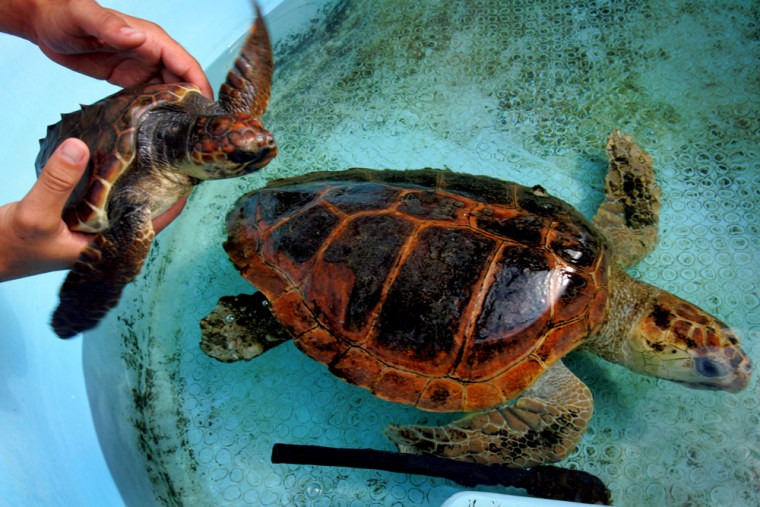Their tracks tell the tale.
Look closely, and you can trace the path of the mighty sea turtle mother as she slides across the beach in search of safe nesting grounds.
Her prints reveal her identity: loggerhead, green or leatherback. They take you where a night's effort took her, which sometimes is back to the ocean after a fruitless trek up the sand.
Otherwise, they lead to her nest, where up to 100 eggs spend two months buried beneath the sand preparing for birth -- if they make it that far.
These days, sea turtles are having a tough time sustaining their species. Longline fishing, pollution, a warming climate and development all have had a hand in the turtle's decline. As nesting season winds down, sea turtle surveyors across Palm Beach County are reporting mixed results.
Known as the "turtle lady," Debbie Sobel, of the Sea Turtle Conservation League of Singer Island, is feeling good about her numbers this year, though she would have liked to see more leatherbacks, the most prehistoric and mammoth of the species, weighing up to a ton. Her numbers were down from last year.
This year, the group tracked 1,020 loggerhead, 222 green and 12 leatherback nests on more than 2 miles of beach from the Ocean Mall in Riviera Beach to John D. MacArthur Beach State Park.
"Of course, we all want to see higher numbers," she said. "We want every species of sea turtles in the world to survive, but they have so many troubles."
Their troubles essentially have been manmade. In Florida, loggerheads are the only one of the seven sea turtle species not considered endangered. Worldwide, though, loggerheads make the list. Longline fishing is the biggest culprit, causing 40,000 deaths each year.
'Very bad few years for the loggerhead'
Loggerhead nesting is declining statewide, but current numbers could be part of a longterm trend, the result of what was happening 20 to 30 years ago, said Carly de Maye, a county environmental analyst. It takes that amount of time for the turtles to reach sexual maturity.
De Maye monitors three beach areas: Ocean Ridge, Carlin Park in Jupiter and Coral Cove in Tequesta. Loggerhead numbers crept up at Ocean Ridge and Carlin Park but fell at Coral Cove. The two increases do not make up for the 21 percent drop in Tequesta, de Maye said.
Getting the loggerheads on the endangered list might help, said Kirt Rusenko, a marine conservationist with Gumbo Limbo Nature Center in Boca Raton.
"It's been a very bad few years for the loggerhead," he said.
In Boca Raton, loggerheads counted one nest better than their record low of 421 nests in 2004. Green sea turtles are doing well at 68 nests and leatherbacks are staying steady in the double digits, this year at 11 nests.
At opposite ends of the county, both Sobel and Rusenko are finding sea turtle nests in the shade of towering condominiums. Restrictions on lights at night are supposed to prevent turtles from becoming disoriented and heading toward traffic or into the hands of predators. The issue is sky glow, the light emitted from homes and downtown areas, Rusenko said.
Light can be lethal for baby turtles, which hatch after dusk. The mothers also prefer darker areas to leave their eggs.
A startling trend in recent years is declining fertility rates, mainly due to pollution, Rusenko said.
While poaching was not a problem on Boca Raton beaches, turtle observers found several nests where no babies hatched.
Stuck under condo stairs
Despite the frustrations, turtle-nesting season is a yearly draw for devotees such as Sobel, who learned the tricks of the trade in Miami 15 years ago. Her group is at the beach at the crack of dawn every day during peak season, March through September.
A poignant moment this season was finding a green sea turtle stuck under condominium stairs. Sobel and her crew dug the turtle out, pouring on buckets of water to keep her comfortable.
"Her carapace (shell) was gleaming in the sun and the pattern was extraordinary," Sobel said.
"It was absolutely breathtaking. That's the kind of thing that blows your mind and keeps you coming year after year."
